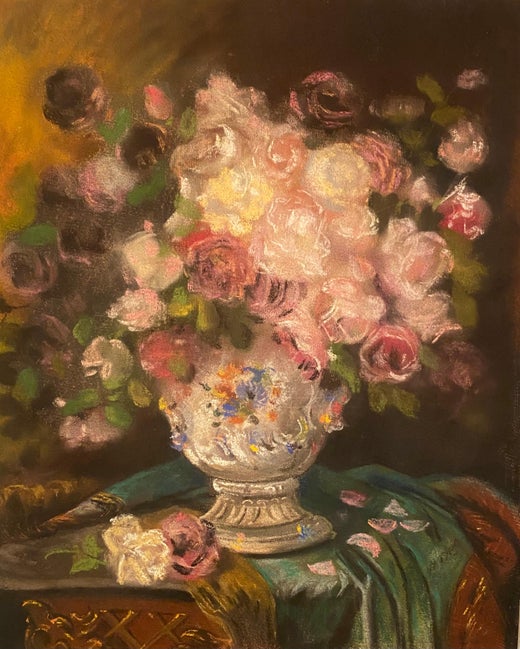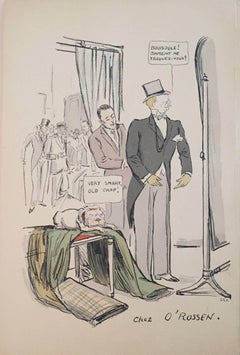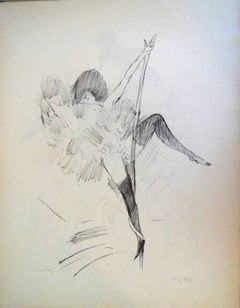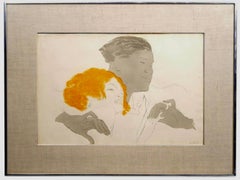Want more images or videos?
Request additional images or videos from the seller
1 of 7
Marcel VertèsCabaret Dancer (ala Toulouse Lautrec)
$1,100List Price
About the Item
- Creator:Marcel Vertès (1895 - 1961, Hungarian)
- Dimensions:Height: 22.38 in (56.85 cm)Width: 17.38 in (44.15 cm)
- Medium:
- Movement & Style:
- Period:
- Condition:minor edge wear. this has never been framed.
- Gallery Location:Surfside, FL
- Reference Number:1stDibs: LU38210752562
Marcel Vertès
Emmanuel Marcel Vertès, born Vértes Marcell in Újpest (Hungary) on 10 August 1895 and died in Paris 16th arrondissement on 31 October 1961, was a Hungarian-born French painter, engraver, illustrator and costume and film designer. After studying with Ferenczy at the Beaux-Arts in Budapest, Marcel Vertès produced political posters during the First World War. Going into exile at the end of the hostilities, like his comrades Mihály Bíró and Róbert Berény, he studied at the Académie Julian in Paris. He made a name for himself in France in the mid-1920s, particularly for his lithographs and illustrations. He published L'heure exquise, a series of erotic engravings, followed by Le pays à mon goût. His favourite subjects were the circus, balls and brothels. His real fame came with an album of lithographs entitled Dancings. Among the works he illustrated were Chéri and La Vagabonde by Colette, L'Europe galante by Paul Morand and Le Cirque by Ramón Gómez de la Serna, published by gallery owners Madeleine and Pierre Trémois. He was associated with the Hungarian cartoonist Alex Szekely.
In the 1930s, he also worked for fashion magazines such as the English edition of Vogue, the American rival Harper's Bazaar and the Gazette du Bon Ton. An engraver, watercolourist and costume designer, this artist also collaborated with Elsa Schiaparelli on numerous occasions, including advertising campaigns for perfumes, the creation of fabrics and even a portrait of the couturier. Mobilised at the start of the war, he was demobilised the following year and left for Biarritz. After passing through Spain, he returned to New York with his wife shortly afterwards and settled in 57th Street, continuing his collaborations and illustrations with the fashion world.
In the early 1950s, Marcel Vertès enjoyed a high profile in artistic circles, justified by a talent often described as exceptional. His drawings were characterised by a great economy of line and colour, and he also produced illustrations in black and white.
It was during this period that he worked on John Huston's Moulin Rouge as costume designer and set designer. He won two Oscars for this film. He moved back to Paris in the late 1950s and died there in 1961.
He is buried in the Père-Lachaise cemetery (90th division).
About the Seller
4.9
Platinum Seller
Premium sellers with a 4.7+ rating and 24-hour response times
Established in 1995
1stDibs seller since 2014
1,839 sales on 1stDibs
Typical response time: 1 hour
Authenticity Guarantee
In the unlikely event there’s an issue with an item’s authenticity, contact us within 1 year for a full refund. DetailsMoney-Back Guarantee
If your item is not as described, is damaged in transit, or does not arrive, contact us within 7 days for a full refund. Details24-Hour Cancellation
You have a 24-hour grace period in which to reconsider your purchase, with no questions asked.Vetted Professional Sellers
Our world-class sellers must adhere to strict standards for service and quality, maintaining the integrity of our listings.Price-Match Guarantee
If you find that a seller listed the same item for a lower price elsewhere, we’ll match it.Trusted Global Delivery
Our best-in-class carrier network provides specialized shipping options worldwide, including custom delivery.You May Also Like
The Three Graces - Original handsigned lithograph
Located in Paris, IDF
Philippe AUGE (1935-)
The Three Graces
Original lithograph
Handsigned in pencil
Limited /275 copies
On vellum 76 x 55.5 cm (c. 29.92 x 21.65 in)
Excellent condition
Category
Late 20th Century Art Deco Figurative Prints
Materials
Lithograph
Tribute to Klimt - Original handsigned lithograph
Located in Paris, IDF
Philippe AUGE (1935-)
Tribute to Klimt
Original lithograph
Handsigned in pencil
Limited /275 copies
On vellum 63 x 79 cm (c. 24.8 x 31.1 in)
Excellent condition
Category
Late 20th Century Art Deco Figurative Prints
Materials
Lithograph
"La Princesse Lointaine", Erte, Original Serigraph numbered 291/300, Art Deco
By Erté
Located in Dallas, TX
"La Princesse Lointaine" is a serigraph created in 1984 by Erté. Classic art deco piece with a gaudy princess in yellow and pink with a star above ...
Category
1980s Art Deco Figurative Prints
Materials
Lithograph, Screen
Tempest, Erté, Original Lithograph (Signed)
By Erté
Located in New York, NY
“Tempest” is a wonderful original Art Deco lithograph created by a famous Russian-born French artist Erté (Romain de Tirtoff).
Image size (with signature): 24 x 19 in.
Framed size: 31 x 25 in.
Edition 184/300.
The artwork is framed.
Signed by the artist on the bottom right corner.
It is in excellent condition.
Known as the “Father of Art Deco,” he created elegant decorative images that are timeless in their beauty and sophistication. Clean lines of his glamorous and evocative works resemble the geometry of Classical Greek pottery and Japanese art of woodblock prints. Erté’s artworks...
Category
Late 20th Century Art Deco Figurative Prints
Materials
Lithograph
Zsa Zsa, Erté, Original Lithograph (Signed)
By Erté
Located in New York, NY
“Zsa Zsa” is a wonderful original Art Deco lithograph created by a famous Russian-born French artist Erté (Romain de Tirtoff).
Image size (with signature): 2...
Category
Late 20th Century Art Deco Figurative Prints
Materials
Lithograph
Reflection, Erté, Original Lithograph (Signed)
By Erté
Located in New York, NY
“Reflection” is a wonderful original Art Deco lithograph created by a famous Russian-born French artist Erté (Romain de Tirtoff).
Image size (including signature): 23 x 17 in.
Framed Size: 31 x 25 in.
Edition 239/300.
The artwork is framed.
Signed by the artist on the bottom right corner.
It is in excellent condition.
Known as the “Father of Art Deco,” he created elegant decorative images that are timeless in their beauty and sophistication. Clean lines of his glamorous and evocative works resemble the geometry of Classical Greek pottery and Japanese art of woodblock prints. Erté’s artworks...
Category
Late 20th Century Art Deco Prints and Multiples
Materials
Lithograph
FRANÇOIS AND A FEW FRIENDS Signed Lithograph Group Fashion Portrait Beret Hats
By Robin Morris
Located in Union City, NJ
FRANÇOIS AND A FEW FRIENDS by the woman artist Robin Morris, is an original limited edition lithograph(not a photo reproduction or digital print) printed using hand lithography techn...
Category
1980s Art Deco Portrait Prints
Materials
Lithograph
$412 Sale Price
25% Off
H 21 in W 29 in
BON VOYAGE Signed Lithograph, Couple Portrait, Art Deco, Cruise Ship Travel
By Robin Morris
Located in Union City, NJ
BON VOYAGE by the woman artist Robin Morris, is an original limited edition lithograph printed using hand lithography techniques on archival Arches paper, 100% acid free. BON VOYAGE ...
Category
1980s Art Deco Portrait Prints
Materials
Lithograph
$464 Sale Price
33% Off
H 21.5 in W 29 in
AT THE CAT CLUB Signed Lithograph, Punk Party Girls, Pearl Choker Necklaces
By Robin Morris
Located in Union City, NJ
AT THE CAT CLUB by the woman artist Robin Morris, is an original limited edition lithograph printed using hand lithography techniques(not a photo reproduction or digital print) on ar...
Category
1980s Art Deco Portrait Prints
Materials
Lithograph
$400 Sale Price
52% Off
H 29 in W 21 in
SPOTLIGHT Signed Lithograph, Man in Tux Playing Grand Piano, Art Deco
By Robin Morris
Located in Union City, NJ
SPOTLIGHT by the woman artist Robin Morris, is an original limited edition lithograph printed using hand lithography techniques(not a photo reproduction or digital print) on archival...
Category
1980s Art Deco Portrait Prints
Materials
Lithograph
$345 Sale Price
40% Off
H 17 in W 13 in
More From This Seller
View AllRare Vintage Art Deco "White Bottoms" Lithograph Pochoir
By Georges Goursat (Sem)
Located in Surfside, FL
This listing is for the one plate. the cover is not included
Lithographs part printed in colour, finished by hand
This portfolio of lively loose pochoir plates sets its sights on pr...
Category
20th Century Art Deco Figurative Prints
Materials
Lithograph
Rare Vintage Art Deco "White Bottoms" Lithograph Pochoir
By Georges Goursat (Sem)
Located in Surfside, FL
This listing is for the one plate. the cover is not included
Lithographs part printed in colour, finished by hand
This portfolio of lively loose pochoir plates sets its sights on pr...
Category
20th Century Art Deco Figurative Prints
Materials
Lithograph
Cabaret Dancer (ala Toulouse Lautrec)
By Marcel Vertès
Located in Surfside, FL
This is an original hand signed (I believe it is also hand colored but i am not positive) Artists Proof Lithograph of a Circus scene. This depicts a Cabaret Dancer.
This came from a...
Category
1940s Art Deco Figurative Prints
Materials
Lithograph
Art Deco Jazz Age Paris Interracial Couple Lovers Marcel Vertes Color Lithograph
By Marcel Vertès
Located in Surfside, FL
Marcel Vertes (French /Hungarian 1895-1961) Tango, from the suite Dancing, Jazz age in Paris. lithograph in colors on paper, published by Gustave Pellet-Paris, hand signed in pencil, lower right.
Mounted in chrome frame with matting. Measures 23.75"H x 30.5"W framed; 15"H x 21.5"W image.
Gustave Pellet (1859–1919) was a French publisher of art. He is best known for publishing prints of erotic artworks by Henri de Toulouse-Lautrec and Louis Legrand.
MARCEL VERTES FRENCH HUNGARIAN 1895 (Ujpest, Hungary) -1961(Paris, France) art deco artist.Vertes was born in Hungary and died in Paris, but spent a lot of time in New York as well. He was noted as a painter, illustrator, designer and scenic mural painter. His whimsical images graced the pages of Vogue and Harper's Bazaar. Continuing in the footsteps of Boutet, Forain, Erte, Toulouse-Lautrec and others. Concentrating upon scenes of Paris street life...
Category
1940s Art Deco Figurative Prints
Materials
Lithograph
1945 Brazilian Master, Art Deco Nudes Serigraph Woodcut Carnaval Bahia
By Odetto Guersoni
Located in Surfside, FL
Genre: Brazilian Art Deco, African Diaspora
Bahian Carnival
Subject: Abstract
Medium: Print
Surface: Paper
Country: Brazil
Dimensions of overall paper are listed.
This is from a series of work he did in the 1940's, we sold one called Ritmo Negro, they are about Afro-Brazilian jazz, dance and music.
Odetto Guersoni was born in the city of Jaboticabal, State of São Paulo, in 1924. From 1936 to 1941 he attended the Liceu de Artes de Ofícios in São Paulo, beginning his artistic career in 1945, when he exhibited paintings in the Hall of the Plastic Artists Union . Two years later he was part of the collective group of 19, alongside Aldemir, Charoux, Otavio Araújo, Grassmann, Maria Leontina and several other artists that time would make famous. He then practiced a figurative painting of accentuated Expressionist lauds, characterized by deformation and coloring, raw and Satirical- as, moreover, so many of his fellow exhibitors at the time. As a French government scholar, Odette Guerzoni went to Paris in 1947 and the following year took part in the Peintres et Graveurs Etrangers and Art Libre exhibitions. Student of engraving by Renê Cottet, gradually transformed this expressive medium into his favorite, to the detriment of painting, which he practically abandoned soon after.
In 1947, he participated in the 19 Painters exhibition at the Prestes Maia Gallery together with Lothar Charoux, Maria Leontina,Grassmann, Aldemir Martins, Luiz Sacilotto and hiró. Guersoni was awarded a scholarship by the French government, and traveled to Paris, where he began work in engraving. Back in Brazil, in 1951, he founded the Art Workshop, in São Paulo. In 1954, he returned to Europe for a year, financed by the International Labor Organization (ILO). In Geneva, he studied engraving with René Cottet (1902 - 1992) and worked in Stanley william Hayter's studio, Atelier 17, in Paris (1901 - 1988). From 1956 to 1957, he became director of the Union of Plastic Artists of São Paulo. From 1960, he attended, as a trainee, some art schools in the United States and Japan such as The New York School of Printing and Osaka University. In 1971, also in Japan, he attended the workshop of I. Jokuriti. Two years later, he was voted Best Recorder of the Year by the Paulista Association of Art Critics - APCA. He took part in a special room at the Ibero-American Biennial in Montevideo in 1983. The Pinacoteca do Estado de São Paulo - Pesp presents a retrospective of his work in 1994.
Odetto Guersoni explores the wide spectrum of possibilities of the engraving. In addition to using techniques such as metal etching, lithograph, serigraph, linocut and, especially, woodcut he developed, in the 1950s, the philigraphy, in which the forms he developed gained points of embroidery made by Bonadei (1906 - 1974) . And, in the 1960s, the plastigraphy, in which he makes engravings on pasty surfaces, obtained from gypsum or other soft material. In the 1970s, technical investigations were associated with pictographic, ideographic, archaic symbol searches, Brazilian cave paintings and plant forms. The drawings are reduced to stylized, geometric shapes and transformed into abstract graphic elements. The artist works with few matrices, which, organized in rectangles, squares or circles, become modules to be combined. Guersoni juxtaposes them, adds, changes colors, and thereby composes colorful mandalas and structural geometries. Based on concise compositions, it produces color vibrations through optical illusions. In many of his woodcut works of the 1980s he uses smooth wood, knives, saws, gouges, punches, avoiding the natural textures of wood. In printing, it leaves the vibrant color and employs dosed inks with colorless masses, obtaining transparencies by superpositions. New journeys of study and specialization in engraving techniques took him in 1954 to Switzerland, 1960 to the United States, and in 1966 to Germany and Austria. Today, after having performed more than 40 individuals including 16 abroad and having participated in more than 50 collectives in several countries, Guersoni is considered one of the most notable Brazilian engravers. Conquered awards in several shows.
CHRONOLOGY
Individual exhibitions
1946 - Sao Paulo SP - 10th Salon of the Artists' Union, at the Prestes Maia Gallery
1947 - São Paulo SP - 19 Painters, at the Prestes Maia Gallery
1948 - Paris France - Peintres et Graveurs Etrangers at the École des Beaux-Arts
1949 - São Paulo SP - 13th Salon of the Artists' Union, at the Prestes Maia Gallery
1951 - São Paulo SP - 1st Paulista Salon of Modern Art, at Prestes Maia Gallery - silver medal
1953 - São Paulo SP - 2nd International Biennial of São Paulo, at MAM / SP
1954 - São Paulo SP - 3rd Paulista Salon of Modern Art, in the Prestes Maia Gallery
1955 - Rio de Janeiro RJ - 4th National Salon of Modern Art
1955 - Salvador BA - 5th Baiano Salon of Fine Arts, in Belvedere da Sé - honorable mention
1962 - São Paulo SP - Leirner Prize for Contemporary Art at the Folha Art Gallery - 1st printing award
1963 - Curitiba PR - 20th Salão Paranaense de Belas Artes, at the Public Library of Paraná
1963 - Rio de Janeiro RJ - Individual, no MAM / RJ
1968 - Bradford England - First International Print Biennale
1970 - São Paulo SP - Antonio Henrique Amaral, Odetto Guersoni, Tomie Ohtake, Pedro Tort and Gerda Brentani, in the Alberto Bonfiglioli Gallery
1971 - São Paulo SP - 11th International Biennial of São Paulo, at the Biennial Foundation - acquisition award
1973 - Punta del Este Uruguay - 1st Engraving Meeting of the Prata Basin Countries - International Prize
1977 - São Paulo SP - The Groups: the 40's, at the Lasar Segall Museum
1982 - São Paulo SP - Ismenia Coaracy, Odetto Guersoni and Alice Brill...
Category
1940s Art Deco Nude Prints
Materials
Woodcut
1945 Brazilian Master, Art Deco Clown Serigraph Woodcut
By Odetto Guersoni
Located in Surfside, FL
Genre: Brazilian Art Deco, African Diaspora
Bahian Carnival
Subject: harlequin clown
Medium: Print
Surface: Paper
Country: Brazil
Dimensions of overall paper are listed.
This is from a series of work he did in the 1940's, we sold one called Ritmo Negro, they are about Afro-Brazilian jazz, dance and music.
Odetto Guersoni was born in the city of Jaboticabal, State of São Paulo, in 1924. From 1936 to 1941 he attended the Liceu de Artes de Ofícios in São Paulo, beginning his artistic career in 1945, when he exhibited paintings in the Hall of the Plastic Artists Union . Two years later he was part of the collective group of 19, alongside Aldemir, Charoux, Otavio Araújo, Grassmann, Maria Leontina and several other artists that time would make famous. He then practiced a figurative painting of accentuated Expressionist lauds, characterized by deformation and coloring, raw and Satirical- as, moreover, so many of his fellow exhibitors at the time. As a French government scholar, Odette Guerzoni went to Paris in 1947 and the following year took part in the Peintres et Graveurs Etrangers and Art Libre exhibitions. Student of engraving by Renê Cottet, gradually transformed this expressive medium into his favorite, to the detriment of painting, which he practically abandoned soon after.
In 1947, he participated in the 19 Painters exhibition at the Prestes Maia Gallery together with Lothar Charoux, Maria Leontina,Grassmann, Aldemir Martins, Luiz Sacilotto and hiró. Guersoni was awarded a scholarship by the French government, and traveled to Paris, where he began work in engraving. Back in Brazil, in 1951, he founded the Art Workshop, in São Paulo. In 1954, he returned to Europe for a year, financed by the International Labor Organization (ILO). In Geneva, he studied engraving with René Cottet (1902 - 1992) and worked in Stanley william Hayter's studio, Atelier 17, in Paris (1901 - 1988). From 1956 to 1957, he became director of the Union of Plastic Artists of São Paulo. From 1960, he attended, as a trainee, some art schools in the United States and Japan such as The New York School of Printing and Osaka University. In 1971, also in Japan, he attended the workshop of I. Jokuriti. Two years later, he was voted Best Recorder of the Year by the Paulista Association of Art Critics - APCA. He took part in a special room at the Ibero-American Biennial in Montevideo in 1983. The Pinacoteca do Estado de São Paulo - Pesp presents a retrospective of his work in 1994.
Odetto Guersoni explores the wide spectrum of possibilities of the engraving. In addition to using techniques such as metal etching, lithograph, serigraph, linocut and, especially, woodcut he developed, in the 1950s, the philigraphy, in which the forms he developed gained points of embroidery made by Bonadei (1906 - 1974) . And, in the 1960s, the plastigraphy, in which he makes engravings on pasty surfaces, obtained from gypsum or other soft material. In the 1970s, technical investigations were associated with pictographic, ideographic, archaic symbol searches, Brazilian cave paintings and plant forms. The drawings are reduced to stylized, geometric shapes and transformed into abstract graphic elements. The artist works with few matrices, which, organized in rectangles, squares or circles, become modules to be combined. Guersoni juxtaposes them, adds, changes colors, and thereby composes colorful mandalas and structural geometries. Based on concise compositions, it produces color vibrations through optical illusions. In many of his woodcut works of the 1980s he uses smooth wood, knives, saws, gouges, punches, avoiding the natural textures of wood. In printing, it leaves the vibrant color and employs dosed inks with colorless masses, obtaining transparencies by superpositions. New journeys of study and specialization in engraving techniques took him in 1954 to Switzerland, 1960 to the United States, and in 1966 to Germany and Austria. Today, after having performed more than 40 individuals including 16 abroad and having participated in more than 50 collectives in several countries, Guersoni is considered one of the most notable Brazilian engravers. Conquered awards in several shows.
CHRONOLOGY
Individual exhibitions
1946 - Sao Paulo SP - 10th Salon of the Artists' Union, at the Prestes Maia Gallery
1947 - São Paulo SP - 19 Painters, at the Prestes Maia Gallery
1948 - Paris France - Peintres et Graveurs Etrangers at the École des Beaux-Arts
1949 - São Paulo SP - 13th Salon of the Artists' Union, at the Prestes Maia Gallery
1951 - São Paulo SP - 1st Paulista Salon of Modern Art, at Prestes Maia Gallery - silver medal
1953 - São Paulo SP - 2nd International Biennial of São Paulo, at MAM / SP
1954 - São Paulo SP - 3rd Paulista Salon of Modern Art, in the Prestes Maia Gallery
1955 - Rio de Janeiro RJ - 4th National Salon of Modern Art
1955 - Salvador BA - 5th Baiano Salon of Fine Arts, in Belvedere da Sé - honorable mention
1962 - São Paulo SP - Leirner Prize for Contemporary Art at the Folha Art Gallery - 1st printing award
1963 - Curitiba PR - 20th Salão Paranaense de Belas Artes, at the Public Library of Paraná
1963 - Rio de Janeiro RJ - Individual, no MAM / RJ
1968 - Bradford England - First International Print Biennale
1970 - São Paulo SP - Antonio Henrique Amaral, Odetto Guersoni, Tomie Ohtake, Pedro Tort and Gerda Brentani, in the Alberto Bonfiglioli Gallery
1971 - São Paulo SP - 11th International Biennial of São Paulo, at the Biennial Foundation - acquisition award
1973 - Punta del Este Uruguay - 1st Engraving Meeting of the Prata Basin Countries - International Prize
1977 - São Paulo SP - The Groups: the 40's, at the Lasar Segall Museum
1982 - São Paulo SP - Ismenia Coaracy, Odetto Guersoni and Alice Brill...
Category
1940s Art Deco Nude Prints
Materials
Woodcut
Recently Viewed
View AllMore Ways To Browse
Art Deco Dance
Art Deco Dancer
Hungarian Art Deco
Vintage Patou
Carlyle Hotel
The Carlyle Hotel
Marcel Vertes Lithograph
Vertes Dancing
Nura Ulreich
Picasso Lithographs Jacqueline
Punk Flyer
Salvador Dali Israel
Seven Deadly Sins
Signed Fernand Mourlot
Toulouse Lautrec Lithograph Circus
1977 Salvador Dali
American Woodblock Prints
Antique Legal Prints



